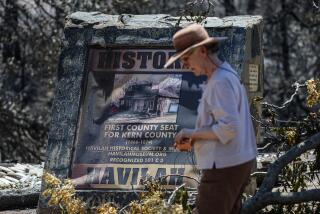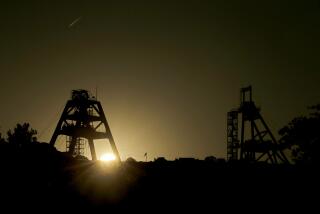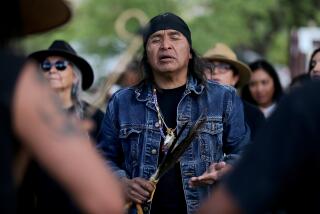Price Is Gamble : Mining Co. Hoping for Gold Rush
LOWER LAKE, Calif. — A mining company is gambling that millions of ounces of gold are buried in the lush Blue Ridge Hills. It is spending $270 million to get to the ore, reviving memories of California’s Gold Rush.
The gamble, for Homestake Mining Co. of San Francisco, centers on the price of gold.
Richard W. Stumbo Jr., Homestake’s chief financial officer, estimates that it will cost $300 to produce each ounce of gold at the new mine. That is the level that gold prices have been hovering at recently.
“If you thought gold was going to sit at $200 to $220, you’d have to close it,” Stumbo said. But Homestake’s financial man doesn’t think that will happen.
“A fair price for gold in today’s dollars is closer to $400,” Stumbo said.
Although the Homestake mine will scar the land for decades, opposition from environmentalists has been muted.
Small Group of Objectors
Those who oppose the plan are a vocal but distinct minority. The jobs and taxes the facility will generate make most people eager to bring the Gold Rush back to California.
On Feb. 5, Homestake began extracting the first quartz-laden gold ore from a huge hole in the ground. Microscopic gold dust is being extracted from the ore by a complex and costly process far removed from the pick-and-shovel method used by the state’s early miners. Homestake expects to turn out its first gold bar in early March.
Over the next 25 years or so, Homestake plans to extract about 3 million ounces of gold from the pit, carving it eventually to one mile long, a third of a mile wide and 450 feet deep. A reservoir created by the diversion of a stream sits a few hundred feet from the pit and will supply the 960 gallons of fresh water needed each minute for the operation.
Five miles away is the plant that will produce the gold and a pond that will collect the project’s waste, which will include some of the large amounts of cyanide used in removing the gold from the rock.
The idea doesn’t please many farmers whose land surrounds the 8,000 acres owned by Homestake. Their opposition, plus the complexity of planning such a project, delayed the mine’s ground breaking until last August, four years after Homestake discovered gold at the site.
But many environmentalists, including the local chapter of the Sierra Club, say Homestake has tried hard to meet their concerns about the mine’s safety.
Homestake’s attempt to recapture the Gold Rush did not come cheap. The company estimated that it has spent $245 million on the new mine, dubbed the McLaughlin Project, and will add another $25 million or so this year.
Declining Gold Prices
Homestake begins its operation at a time of declining gold prices that are eroding Homestake’s revenues and profits.
Sales for the first nine months of 1984 were $248 million, down from $255.4 million during the same period of 1983. Profits took a bigger slide, dropping to $27 million, or 55 cents a share, for the first nine months of 1984, compared to $46.9 million, or 93 cents a share, the year before.
The mine sits at the junction of Napa, Lake and Yolo counties, about 80 miles north of San Francisco. Virtually no opposition was heard in either Napa or Lake, where the greatest employment and tax benefits will be felt.
But the farmers in Yolo County put up a fight. In 11 days, they collected 3,500 signatures on a petition asking supervisors to block the mine, although they failed to get enough to put the question on the county ballot.
Many environmentalists have mostly good things to say about Homestake’s McLaughlin Project.
Ada Merhoff of the Yolo/Solano chapter of the Sierra Club noted that her group does not oppose mining. After two engineers she hired said that Homestake’s environmental impact report for the project was “the best they had ever seen,” she had little opposition.
Joe Callizo, president of the Napa Valley chapter of the California Native Plant Society, said Homestake changed the mine’s layout to help save half of the 60 species of endangered plants that grow on or near the site.
“There’s positive and negative. You have to weigh things out,” Callizo said. “Gold is valuable. Jobs are valuable.”
More to Read
Inside the business of entertainment
The Wide Shot brings you news, analysis and insights on everything from streaming wars to production — and what it all means for the future.
You may occasionally receive promotional content from the Los Angeles Times.










